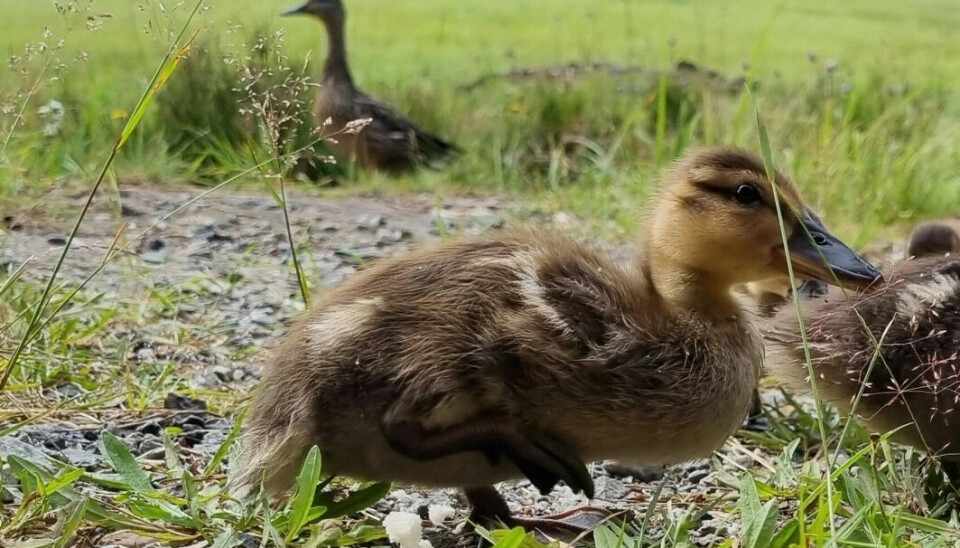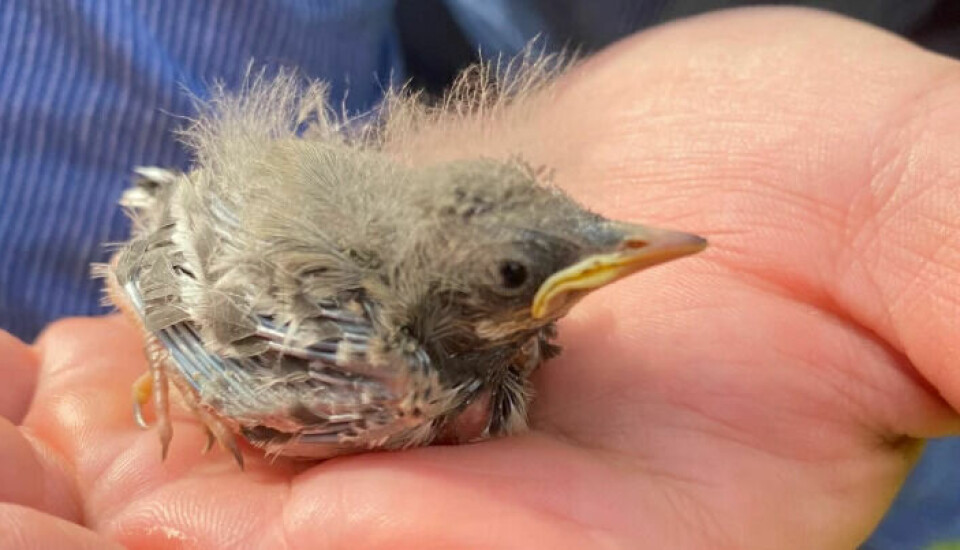
Should you help injured birds?
A little duckling has injured its foot. Should you help, kill it or do nothing?
A hen and her eleven cute ducklings waddled up to our cabin every day to get breadcrumbs. One day, one of the ducklings came far behind the others. It hopped clumsily on one leg and was unable to use the other.
When the other ducklings quickly darted back to the pond, it took a long time for the injured duckling. The hen waited patiently but did not help.
The discussion went on loudly amongst those on the terrace. Should we help? Put the duckling into a tub of water? Feed it? Take it to the vet? Would it be better off with us than in the brood? Or was it best to leave it alone?

Save, kill or do nothing?
“This is a big discussion. Whether we should make an effort for individual animals or whether we should work to save animal species,” Svein Dale says. He is a professor at the Norwegian University of Environmental and Life Sciences, NMBU.
He himself does not encounter the problem often. Dale does research on wild birds out in nature.
“It's rare that I find an injured bird out in the wild. If a bird cannot move, it's quickly taken by predators,” Dale tells sciencenorway.no.
It's more common to find abandoned baby birds and injured birds in gardens and around the city. So what should we do then?
“We should leave them alone. Most people do not have enough knowledge to recognise whether baby birds need help,” says Dale.
He makes exceptions for some injured birds.
“If it is a very rare bird species, we can do more to save individuals. For more common birds, it makes the most sense to put them down,” he says.
“Our fault, our responsibility”
The nature conservation organisation Birdlife Norway works to take care of our birds. Håkan Billing is head of the department in Oslo and Akershus. He believes that there is no definitive answer for what we should do when we find injured birds.
“It depends on what injuries the bird has. If it has been injured in traffic, flew into a window, or got a fishhook stuck in it, we humans are to blame for the injuries. Then it is our responsibility, and we should help the bird,” Billing says.
He encourages us to take the injured bird to the vet. If we try to help ourselves, without knowledge of injuries or bird behaviour, we can worsen and prolong its suffering.
“On the other hand, if the bird has become ill or injured in a natural way, we should not interfere in the course of nature, even if it is brutal,” he says. “It is not easy to assess whether an injured bird needs help. Many injuries will heal themselves.”
If we find a baby bird, however, he is quite clear:
“You should never take a baby bird with you. This is very important. It will be like kidnapping baby birds from their parents,” says Billing.

Leave the baby birds alone
“I get called all the time about baby birds,” Pelle Wickstrøm says. He is the leader of the volunteer organisation Fuglehjelpen, the bird help.
“It's important that people learn that baby birds are not abandoned, even if the parents are not around,” he says.
Leave them alone, urges Wickstrøm. If you bring the baby bird home, you may feed it the wrong food, feed it too often or not often enough.
“If you feed bread to one species of bird, it may die because it only eats fish. But if you give fish to another bird species, it dies. Everyone thinks that baby birds eat earthworms, but some die from those too,” Wickstrøm says.
Nowadays people call about baby seagulls. There are many of them in the cities.
It takes several weeks from the time a young seagull leaves the nest until it can fly. That's why there are many young seagulls on the ground in the cities in the summer. In one day, Fuglehjelpen found 18 seagull chicks on the main street of Oslo, Karl Johan, and almost 100 around Oslo City Hall.
“People get anxious if they see a young seagull two days in a row. They think something is wrong,” says Wickstrøm.
“But the parents are probably out fishing or finding other food,” he assures.
“We have to endure the course of nature”
The baby birds we find may look injured even if they are not, according to Fuglehjelpen. They get many calls from people who think they have found injured chicks.
“Normally, they just haven’t fully developed their bones and wings yet. Young seagulls often support themselves on their wing, just like old people use canes,” Wickstrøm says.
And if they have an injury, they heal well.
“We have to endure the course of nature,” he says.
Duty to help
The Animal Welfare Act states that if we come across a sick or injured animal, we have a duty to help it. We must decide for ourselves whether to kill it or take it to the vet.
The Norwegian Food Safety Authority (link in Norwegian) writes that we usually help sick and injured birds by euthanising them. If we are unable to do it ourselves, we must call the police or take it to a vet.
“If the baby bird is injured, it will probably be put down because it is difficult to rehabilitate wild birds, Mari Skare Furuseth writes in an e-mail to sciencenorway.no. She is a vet tech at the Veterinary Hospital at NMBU.
“If it is not injured, it should be put back where it was found as long as the parents have been observed nearby. If it only has minor damage, we will try to contact voluntary organisations, such as Fugleadvokatene (The Birds Advocates) or Fuglehjelpen (The Bird Help),” she says.
Furuseth recommends that we take injured baby birds to the nearest open vet. In Norway, they have a duty to perform emergency care or euthanise without you having to pay for it.
The duckling on one leg
So how did the one-legged duckling at the cabin fare?
We went home without helping and without knowing if that was the right decision.
Two weeks later we were back. The flock of ducks came back for more bread.
And in the middle of the flock, one of them limped, faster and stronger than before. It could step on its leg, even though it was still injured.
We left it alone.
In the video below, you can see the lame duckling a couple of weeks after we first noticed it was injured. Now it can walk on its legs and moves almost as fast as the others.
———
Translated by Alette Bjordal Gjellesvik.
Read the Norwegian version of this article on ung.forskning.no
------

































